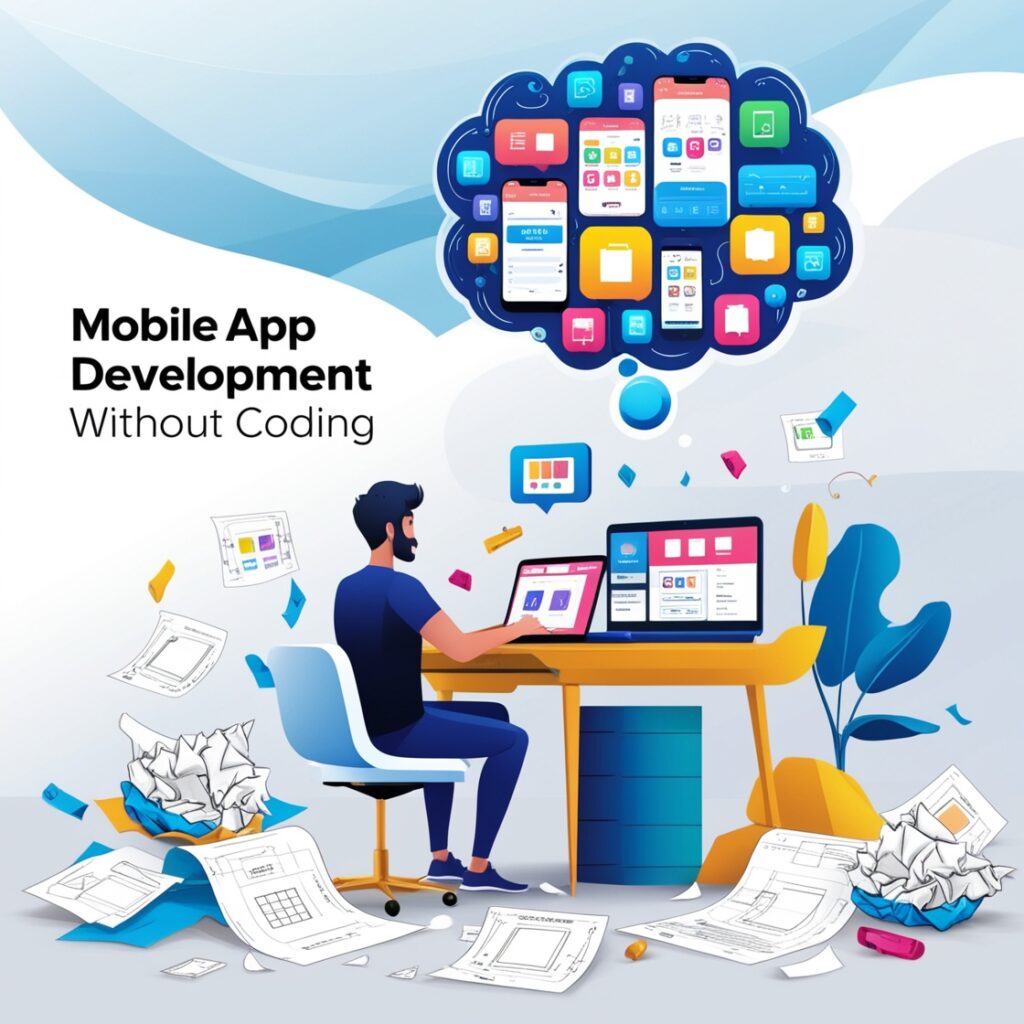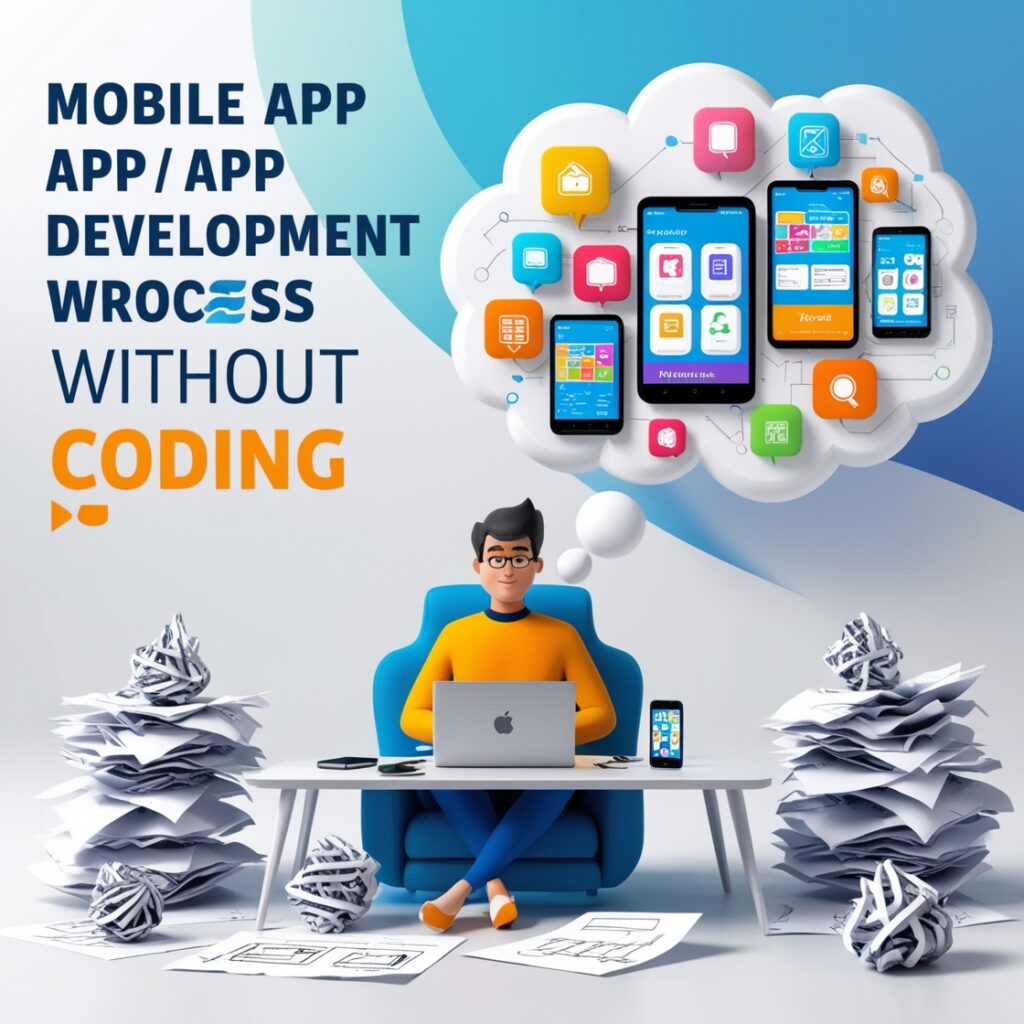In today’s tech-driven world, you don’t need to be a programmer to create your dream app. With the rise of no-code and low-code platforms, building a mobile app without coding has become more accessible than ever. This guide will walk you through the steps to design, build, and launch a fully functional app—no coding required!
Why Build a Mobile App Without Coding?
Creating a mobile app without coding saves time, money, and resources. It’s an excellent option for:
• Entrepreneurs: Test business ideas quickly without hiring developers.
• Small Businesses: Build customer-facing apps on a budget.
• Beginners: Learn app-building fundamentals without diving into programming languages.
Step 1: Define Your App Idea
Start by clarifying your app’s purpose. Ask yourself:
1. What problem does my app solve?
2. Who is my target audience?
3. What features should the app include?
Example: If you’re building a fitness tracker app, features might include step counting, workout logging, and progress tracking.
Step 2: Choose the Right No-Code Platform
Several no-code platforms are tailored for building mobile apps without coding. Here are some popular options:
• Glide: Ideal for apps based on Google Sheets, perfect for managing data-driven tasks.
• Adalo: A drag-and-drop builder for creating professional apps with custom designs.
• Thunkable: Great for beginners and supports both iOS and Android deployment.
• Bubble: More advanced but highly flexible for building complex apps.
• AppGyver: Free and suited for both simple and complex app ideas.
Step 3: Design Your App
Most no-code platforms provide templates and drag-and-drop interfaces, making it easy to create a visually appealing app.
1. Choose a Template: Select a layout that fits your app’s purpose.
2. Customize the Design: Update colors, fonts, and icons to match your brand.
3. Add Visual Elements: Incorporate engaging images, buttons, and animations.
Pro Tip: Keep your design intuitive and user-friendly. Simple navigation improves the user experience.
Step 4: Add Features and Functionality
No-code platforms allow you to add app features without writing code. Common features include:
• User Registration: Let users create accounts or sign in via social media.
• Push Notifications: Keep users informed and engaged.
• Payment Integration: Add payment gateways like Stripe or PayPal for e-commerce apps.
• Real-Time Chat: Include messaging features for social or support apps.
Many platforms also support API integration, allowing you to connect external tools like Google Maps or CRM systems.
Step 5: Test Your App
Before launching, test your app to ensure it runs smoothly on different devices.
• Device Testing: Check how your app looks and functions on both Android and iOS devices.
• User Feedback: Share your app with a small group of users and gather feedback on design and usability.
• Bug Fixing: Resolve any issues or glitches during testing.
Most platforms provide built-in testing tools to streamline this process.
Step 6: Publish Your App
Once you’re confident in your app’s performance, it’s time to publish it.
1. Choose a Plan: No-code platforms often require a subscription to publish your app.
2. Register as a Developer: Sign up for Apple’s App Store ($99/year) and Google Play Store ($25 one-time fee).
3. Submit Your App: Follow platform guidelines to submit your app for approval.
Pro Tip: Optimize your app listing with an engaging description, screenshots, and relevant keywords like “mobile app without coding” to attract downloads.
Examples of Apps Built Without Coding
Many successful apps started with no-code platforms. Here are a few examples:
• Startups: A delivery app built with Glide for tracking and managing orders.
• Nonprofits: An event management app created using Adalo for organizing community events.
• Freelancers: A personal finance tracker developed with Thunkable to manage budgets.
Benefits of Building a Mobile App Without Coding
• Cost-Effective: No need to hire developers, saving thousands of dollars.
• Fast Development: Launch your app in weeks or even days.
• Full Control: Easily update and manage your app on your own.
Tips for Success
• Start Small: Focus on building a Minimum Viable Product (MVP) to test your idea.
• Leverage Tutorials: Most no-code platforms offer step-by-step guides to help you get started.
• Promote Your App: Use social media, email marketing, and app store optimization (ASO) to grow your user base.

Beginner’s Guide to Building a Mobile App Without Coding: Advanced Insights
Building a mobile app without coding is not only simple but also a stepping stone to digital success. If you’re ready to dive deeper, here are some advanced tips, strategies, and tools to take your app from good to great!
Step 7: Optimize Your App for Performance
Users demand speed and reliability. Make sure your app runs seamlessly:
• Reduce Loading Times: Compress media files and avoid heavy animations.
• Ensure Compatibility: Test your app on various devices and operating systems (both iOS and Android).
• Monitor App Metrics: Use tools like Firebase or AppGyver Analytics to track performance and user behavior.
Step 8: Incorporate Advanced Features
Want your app to stand out? Consider these enhancements:
1. AI Integration: Add chatbots or recommendation engines to personalize the user experience.
2. Location Services: Use GPS functionality to offer location-based features.
3. Offline Access: Allow users to access some content or features without an internet connection.
4. Gamification: Introduce badges, leaderboards, or rewards to engage users.
Step 9: Build a Marketing Strategy for Your App
Launching your app is just the beginning. Attract users with an effective marketing plan:
1. App Store Optimization (ASO): Use keywords like “mobile app without coding” in your app title, description, and tags.
2. Social Media Campaigns: Share your app launch on platforms like Instagram, LinkedIn, and Facebook.
3. Content Marketing: Write blog posts, tutorials, or videos about your app’s features and benefits.
4. Collaborate with Influencers: Partner with creators in your niche to promote your app.
Step 10: Monetize Your App
If you’re looking to generate income from your app, consider these monetization strategies:
• In-App Purchases: Offer premium features, additional content, or virtual goods.
• Subscriptions: Charge users a recurring fee for access to exclusive features.
• Ads: Partner with ad networks like Google AdMob to display advertisements.
• Affiliate Marketing: Promote relevant products or services and earn commissions.
Pro Tip: Focus on user value. Monetization should enhance, not disrupt, the user experience.
Step 11: Continuously Update Your App
User needs and expectations evolve. Regular updates keep your app relevant:
1. Fix Bugs: Address issues reported by users.
2. Add Features: Respond to feedback by introducing features users want.
3. Update Content: Keep your app’s information and visuals fresh.
Most no-code platforms allow you to push updates seamlessly without re-submitting your app to stores.
Tools to Make Your No-Code App Shine
1. Zapier: Automate workflows between your app and other tools like email or CRM platforms.
2. Integromat: Advanced automation for connecting APIs to your app.
3. Canva: Design custom app icons, banners, and promotional graphics.
4. Google Firebase: Add user authentication, cloud storage, and real-time analytics.
5. Figma: Design and prototype app layouts before building them.
Mistakes to Avoid When Building a Mobile App Without Coding
1. Skipping User Testing: Test your app with real users to identify pain points early.
2. Overloading Features: Keep it simple—focus on the most important features first.
3. Ignoring User Feedback: Engage your users and iterate based on their suggestions.
4. Neglecting Security: Use secure platforms and add features like encryption to protect user data.
5. Launching Without Marketing: A great app will struggle without proper promotion.
Inspiration: Apps Built Without Coding
Here are a few success stories of apps built without a single line of code:
• Run The World: Created for virtual events, built using a combination of no-code tools.
• Visual Stories: A storytelling app created using Glide, showcasing user-generated content.
• Carrd: A portfolio and landing page app built entirely without coding knowledge.
These examples prove that mobile app without coding isn’t just a trend—it’s a viable pathway to success.

The Future of No-Code Development
In 2024 and beyond, no-code platforms are set to revolutionize app development. From AI-powered customization to blockchain integration, these tools continue to evolve, empowering creators of all backgrounds.
Conclusion
Building a mobile app without coding is no longer a challenge. By choosing the right platform, focusing on user needs, and leveraging advanced tools, you can create a professional app that stands out in the crowded app market.
Take the leap, and let your creativity shine. Your app idea could be the next big thing!
Ready to get started? Share your app-building journey in the comments, or reach out if you need help along the way!
Let us know your experience in the comments, or reach out if you need guidance!




Your point of view caught my eye and was very interesting. Thanks. I have a question for you.
Your point of view caught my eye and was very interesting. Thanks. I have a question for you.
Your article helped me a lot, is there any more related content? Thanks!